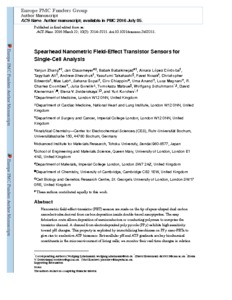Zhang, Y;
Clausmeyer, J;
Babakinejad, B;
Córdoba, AL;
Ali, T;
Shevchuk, A;
Takahashi, Y;
Novak, P;
Edwards, C;
Lab, M;
et al.
Zhang, Y; Clausmeyer, J; Babakinejad, B; Córdoba, AL; Ali, T; Shevchuk, A; Takahashi, Y; Novak, P; Edwards, C; Lab, M; Gopal, S; Chiappini, C; Anand, U; Magnani, L; Coombes, RC; Gorelik, J; Matsue, T; Schuhmann, W; Klenerman, D; Sviderskaya, EV; Korchev, Y
(2016)
Spearhead Nanometric Field-Effect Transistor Sensors for Single-Cell Analysis.
ACS Nano, 10 (3).
pp. 3214-3221.
ISSN 1936-086X
https://doi.org/10.1021/acsnano.5b05211
SGUL Authors: Sviderskaya, Elena Vladimirovna
![[img]](https://openaccess.sgul.ac.uk/108423/3.hassmallThumbnailVersion/emss-67059.pdf)  Preview |
|
PDF
Accepted Version
Available under License ["licenses_description_publisher" not defined].
Download (1MB)
| Preview
|
Abstract
Nanometric field-effect-transistor (FET) sensors are made on the tip of spear-shaped dual carbon nanoelectrodes derived from carbon deposition inside double-barrel nanopipettes. The easy fabrication route allows deposition of semiconductors or conducting polymers to comprise the transistor channel. A channel from electrodeposited poly pyrrole (PPy) exhibits high sensitivity toward pH changes. This property is exploited by immobilizing hexokinase on PPy nano-FETs to give rise to a selective ATP biosensor. Extracellular pH and ATP gradients are key biochemical constituents in the microenvironment of living cells; we monitor their real-time changes in relation to cancer cells and cardiomyocytes. The highly localized detection is possible because of the high aspect ratio and the spear-like design of the nano-FET probes. The accurately positioned nano-FET sensors can detect concentration gradients in three-dimensional space, identify biochemical properties of a single living cell, and after cell membrane penetration perform intracellular measurements.
| Item Type: |
Article
|
| Additional Information: |
This document is the Accepted Manuscript version of a Published Work that appeared in final form in ACS Nano, copyright © American Chemical Society after peer review and technical editing by the publisher. To access the final edited and published work see https://doi.org/10.1021/acsnano.5b05211 |
| Keywords: |
ATP, FET, biosensor, nanoelectrode, nanopipette, nanosensor, scanning probe microscopy, Adenosine Triphosphate, Biosensing Techniques, Cell Line, Tumor, Disulfides, Electrodes, Enzymes, Immobilized, Equipment Design, Hexokinase, Humans, Molybdenum, Nanostructures, Polymers, Pyrroles, Saccharomyces cerevisiae, Single-Cell Analysis, Transistors, Electronic, Cell Line, Tumor, Humans, Saccharomyces cerevisiae, Disulfides, Molybdenum, Pyrroles, Polymers, Enzymes, Immobilized, Hexokinase, Adenosine Triphosphate, Equipment Design, Biosensing Techniques, Electrodes, Nanostructures, Transistors, Electronic, Single-Cell Analysis, scanning probe microscopy, FET, biosensor, ATP, nanosensor, nanopipette, nanoelectrode, MD Multidisciplinary, Nanoscience & Nanotechnology |
| SGUL Research Institute / Research Centre: |
Academic Structure > Molecular and Clinical Sciences Research Institute (MCS) |
| Journal or Publication Title: |
ACS Nano |
| ISSN: |
1936-086X |
| Language: |
eng |
| Dates: |
| Date | Event |
|---|
| 22 March 2016 | Published | | 1 February 2016 | Published Online | | 27 January 2016 | Accepted |
|
| Publisher License: |
Publisher's own licence |
| Projects: |
|
| PubMed ID: |
26816294 |
| Web of Science ID: |
WOS:000372855400022 |
 |
Go to PubMed abstract |
| URI: |
https://openaccess.sgul.ac.uk/id/eprint/108423 |
| Publisher's version: |
https://doi.org/10.1021/acsnano.5b05211 |
Statistics
Item downloaded times since 18 Feb 2020.
Actions (login required)
 |
Edit Item |



